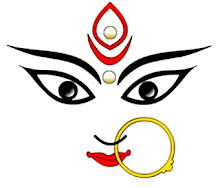 The Bhagawati temple at Kodungallur in Kerala is an ancient one, enshrining Kali - also believed to be a manifestation of Kannagi of the celebrated Tamil epic Silappadikaram. Here is a collection of Shiva temples in Tamilnadu where the Amman (Ambaal or Devi) shrine is of significance.
The Bhagawati temple at Kodungallur in Kerala is an ancient one, enshrining Kali - also believed to be a manifestation of Kannagi of the celebrated Tamil epic Silappadikaram. Here is a collection of Shiva temples in Tamilnadu where the Amman (Ambaal or Devi) shrine is of significance.
Showing posts with label kaalitemples. Show all posts
Showing posts with label kaalitemples. Show all posts
14 August 2009
Shakthi Sthalams - The Bhagawati Temple at Kodungallur- Kerala
 The Bhagawati temple at Kodungallur in Kerala is an ancient one, enshrining Kali - also believed to be a manifestation of Kannagi of the celebrated Tamil epic Silappadikaram. Here is a collection of Shiva temples in Tamilnadu where the Amman (Ambaal or Devi) shrine is of significance.
The Bhagawati temple at Kodungallur in Kerala is an ancient one, enshrining Kali - also believed to be a manifestation of Kannagi of the celebrated Tamil epic Silappadikaram. Here is a collection of Shiva temples in Tamilnadu where the Amman (Ambaal or Devi) shrine is of significance.
The Bhagawati temple at Kodungallur is of great renown throughout the state of Kerala. Kodungallur situated on the west coast, was once a great port of the Chera rulers of Tamilnadu, It was known by the Greek as as the musris.
Tiruvanchikkulam, now a suburb of Kodungallur was a center of great historic significance during the chera period. Cheran Senguttuvan is said to have built the temple to Kannagi - a manifestation of Kaali or Kotravai or Durga, here (Silappadikaaram).It is believed to have been a Shiva temple originally, as worship is offered first to Shiva before being offered to Bhagawati, and there is a mandapam in front of the shiva shrine, and there is none infront of Bhagawatis. The image of Bhagawati is believed to have been carved out of a jack fruit three. The face of the image is covered with a mask, and the image is decorated with several pieces of jeweelry.
Legends: This image is believed to be a personification of Kali, who had killed the demon Daaruka. Daaruka is said to have worshipped Bhrama, and harassed the devas. The goddesses created Bhramani, Vaishnavi, Maheswari, Kaumari, Varahi and Indrani from Bhrama, , and they were defeated by Daaruka, however Shiva created Kaali and she killed Daaruka.
The Temple: The image of Kali faces east. There is a crimson cloth hung on the western wall of the sanctum and worship is offered here. There is also a secret chamber east of the Kali image, with an underground passage. Also is a shrine to Kshetrapala, the guardian deity and Vasurimala associated with small pox.
*****************************************
With this post, my Chapters on Shakthi Sthalams/Temples comes to a close. My next Chapters will be on the Surya Sthalams/ Temples.
Keep viewing....
Shakthi Sthalams - Kalighat Kali Temple, Calcutta
 The Kalighat Kali temple in Calcutta in Bengal is one of the most visited temples in Eastern India, and is regarded as one of the Shakti Peethams of the Indian subcontinent.
The Kalighat Kali temple in Calcutta in Bengal is one of the most visited temples in Eastern India, and is regarded as one of the Shakti Peethams of the Indian subcontinent.
Kalighat is located in the city of Calcutta on the banks of the river Hooghly (Bhagirathi). The name Calcutta is said to have been derived from the word Kalighat.
Kaali is regarded as one of the principal deities of Bengal. There are other temples to Kaali - Sahasrabhuja Kaali, Sarvamangala, Tarasundari and Simhavaahini. Kaali is regarded as the destroyer or liberator and is depicted in a fearful form. Despite the terrifying form, she is considered to deliver bliss to worshippers. The Kalighat temple attracts numerous devotees throughout the year.
Kalighat is regarded as one of the 52 Shakti Peethams of India, where the various parts of Sati's body are said to have fallen, in the course of Shiva's Rudra Tandava. Kalighat represents the site where the toes of the right foot of Shakti or Sati fell.
The Temple: The Kalighat temple in its present form iis only about 200 years old, although it has been referred to in Mansar Bhasan composed in the 15th century, and in Kavi Kankan Chandi of the 17th century.
Legend says that a devotee discovered a luminant ray of light coming from the Bhagirathi river bed, and upon investigating its source came upon a piece of stone carved in the form of a human toe. He also found a Syayambhu Lingam of Nakuleshwar Bhairav nearby, and started worshipping Kaali in the midst of a thick jungle. This shrine grew to its present form over a period of time, thanks in particular to the Sabarna Roy Chowdhury family of Bengal.
This family is also said to have built the Chitreswari Kaali temple at Chitpur. It is believed that there was a pathway through the jungle between Chitpur and Kalighat, and this pathway is said to have become the Chitpur road of Calcutta.
Kalighat is also associated with the worship offered to Kaali by a Dasanami Monk by name Chowranga Giri, and the Chowringee area of Calcutta is said to have been named after him.
The Dakshineswar Kaali temple across from the river, near Belur Math, bears an image of Kaali worshipped by the spiritual leader Ramakrishna Paramahamsa, guru of Swami Vivekananda.
13 August 2009
SHAKTHI STHALAMS - SAMAYAPURAM MAARIAMMAN TEMPLE
 The Maariamman Temple at Samayapuram in the vicinity of Tiruchirappalli is one of the well visited shrines in Tamilnadu, dedicated to Maariamman, a manifestation of the primeval energy Shakti as the mother Goddess.
The Maariamman Temple at Samayapuram in the vicinity of Tiruchirappalli is one of the well visited shrines in Tamilnadu, dedicated to Maariamman, a manifestation of the primeval energy Shakti as the mother Goddess.
Maariamman: Local variations of the worship of Shakti, the mother Goddess are seen throughout the Indian subcontinent. Mariamman is a form of Shakti worshipped in Tamilnadu, and is associated with prosperity and health. Local beliefs associate this deity with cures for diseases such as small pox and chicken pox.
Legend has it that Shiva created Kali, out of the poison that he had swallowed, and decreed that he kill Daarukaasuran. Having originated from the Kaalakoota poison, she assumed the name Kaali. Mariamman is believed to be a form of Kaali, and is also known as Mahamaayi or Seethala Gowri.
Legends surrounding Samayapuram: Dasaratha, father of Rama is said to have worshipped here. It is believed that the processional image of Mariamman was in the possession of the Vijayanagar monarchs and that as their empire neared destruction, this image was brought down to Tamilnadu in an ivory palanquin. It is believed that the palanquin beare rs placed image on the ground and paused for rest, and then found themselves to be unable to lift it off the ground. A temple was then established in the vicinity of Tiruchirappalli, which was later expanded by Vijayaranga Chokkanatha Nayak of Madurai of the 18th century.
Samayapuram was a local capital of the Vijayanagar rulers in the vicinity of Tiruchirappalli, and was known as Vikramapuram.
rs placed image on the ground and paused for rest, and then found themselves to be unable to lift it off the ground. A temple was then established in the vicinity of Tiruchirappalli, which was later expanded by Vijayaranga Chokkanatha Nayak of Madurai of the 18th century.
Samayapuram was a local capital of the Vijayanagar rulers in the vicinity of Tiruchirappalli, and was known as Vikramapuram.
 rs placed image on the ground and paused for rest, and then found themselves to be unable to lift it off the ground. A temple was then established in the vicinity of Tiruchirappalli, which was later expanded by Vijayaranga Chokkanatha Nayak of Madurai of the 18th century.
Samayapuram was a local capital of the Vijayanagar rulers in the vicinity of Tiruchirappalli, and was known as Vikramapuram.
rs placed image on the ground and paused for rest, and then found themselves to be unable to lift it off the ground. A temple was then established in the vicinity of Tiruchirappalli, which was later expanded by Vijayaranga Chokkanatha Nayak of Madurai of the 18th century.
Samayapuram was a local capital of the Vijayanagar rulers in the vicinity of Tiruchirappalli, and was known as Vikramapuram.
The Temple: This temple has separate shrines for the processional image of Mariamman and the moolavar in the sanctum. There is also a shrine to Karuppannasaami a local deity.
Festivals: Several worship services are offered throughout the day here. Offerings of salt, jaggery (brown sugar), lentils, jewelry are made by devotees. Annual festivals are celebrated during Thai Poosam, and in the tamil months of Pankuni and Chittirai. The last Sunday of Pankuni marks the commencement of the festival, while the chariot festival is celebrated on the first Tuesday in the month of Chittirai, and the float festival is celebrated a week later.
Subscribe to:
Posts (Atom)






















